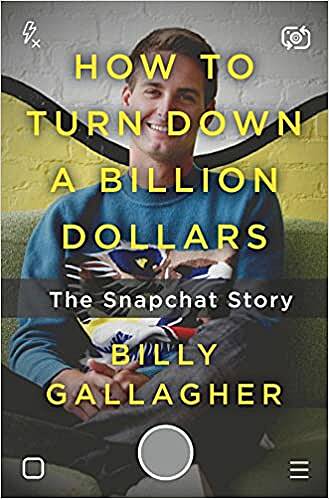
My highlights from the book:
1. Evan decided to study product design, to learn how to look at the things he used in his daily life and see how he could make them better and cooler.
2. One thing was clear; as he frequently put it, “I’m not going to work for someone else.”
3. While the outcome was disappointing, Evan learned a valuable lesson: in order to avoid getting destroyed by better-funded competition, his next idea had to be more original.
4. Evan talked about how weird it was that whoever started the internet and Facebook just decided that everything should stick around forever.
5. The response was less than enthusiastic. Why would anyone use this app? This is the dumbest thing ever. One of the venture capitalists suggested Evan make the photos permanent and work with Best Buy for photos of inventory.
6. Evan studied the hundred most popular apps in the App Store and noticed that none had yellow logos.
7. When everyone is tired and the night is over, who stays and helps out? Because those are your true friends.
8. Evan wanted to build Snapchat as an art and technology company, modeled after two of his heroes, Edwin Land and Steve Jobs. Jobs had also considered Land a personal hero and someone he modeled his career after.
9. Like Land and Jobs, Evan was more of a discoverer than an inventor. He also didn’t believe users could tell him what they wanted—he simply had to discover what was next and show it to them.
10. They knew Snapchat had value, because everyone who used the app used it all the time. They just needed to get it into more people’s hands and make it grow.
11. They started showing it to people one on one, even downloading the app for them.
12. Evan would go to the mall and hand out flyers advertising Snapchat.
13. Evan designed Snapchat as an antidote to this obsession with likes and retweets. Snapchat was not meant to be a social network — it was designed as a small, private network. Snapchat had no likes, no permanence, no social anxiety.
14. If Instagram is the prettiest 1% of photographs, Snapchat would happily host the rest of the 99%.
15. It only recently occurred to me, while preparing this address, how totally absurd this whole charade was. It reminded me that oftentimes we do all sorts of silly things to avoid appearing different. Conforming happens so naturally that we can forget how powerful it is — we want to be accepted by our peers — we want to be part of the group. It’s in our biology. But the things that make us human are those times we listen to the whispers of our soul and allow ourselves to be pulled in another direction.
16. More than 10,000 people were downloading Snapchat every day. It grew from 100,000 to 1,000,000 in six months.
17. There’s no way I’m going to work for anybody else. I don’t think you’re going to see us selling any time soon.
18. He is a very private, often secretive person.
19. People wonder why their daughter is taking 10,000 photos a day. What they don’t realize is she isn’t preserving images. She’s talking.
20. The brilliance of Stories was everything that wasn’t in it; with no permanence, fancy editing, likes, follower counts, or comments.
21. He was obsessed with Snapchat being a permanent company as he was with Snapchat being an impermanent product. This is the best idea Evan will ever have. He will not sell it to someone else.
22. We are able to communicate through photos, not just communicate around them like we did on social media.
23. That’s what Snapchat is all about. Talking through content, not around it. With friends, not strangers.
24. Snapchat never announces its acquisitions.
25. Humans are full of contradictions. We change. That is the joy of human life. We are not brands; it is not in our nature.
Learn more ideas from history's greatest entrepreneurs by listening to Founders podcast.